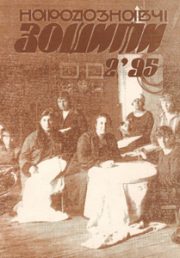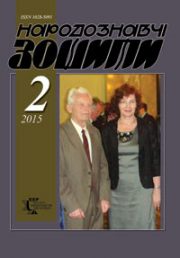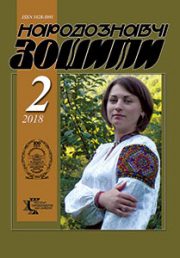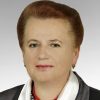The Ethnology Notebooks. 2025. № 4 (184), 831—840
UДК: 39:069/014+069.8+061.22(045)(477.8)”18/19″
DOI https://doi.org/10.15407/nz2025.04.831
KUSHNIR Vitalii
- ORCID ID: https://orcid.org/0000-0001-8809-0108
- Candidate of Historical Science,
- Senior Research Fellow,
- Museum of Ethnography and Art Crafts
- Of the Institute of Ethnology of the National Academy of Sciences of Ukraine,
- 15, Svobody ave., 79000, Lviv, Ukraine,
- Contacts: e-mail: vitaliy_val@ukr.net
Abstract. The aim of the study is to determine the place of ethnography and ethnographic collections in the public life of the Galician lands of the late nineteenth and early twentieth centuries, including it in the cultural, primarily museum, as well as political and economic aspects.
During this period, ethnography was established as an important component of the museum and exhibition space of Galicia. Ethnographic collections representing the traditional culture of the rural population of the region became part of the collections of a number of museum institutions. For the Ukrainian community of the imperial province, ethnography became an element of public manifestation of its national identity, and at the same time a means of national self-reflection in its cognitive, educational, and aesthetic aspects. The work on the formation of ethnographic collections in Ukrainian museums was one of the forms of self-organisation of the Ukrainian population, which had not only a Galician but also a nationwide dimension. The holding of ethnographic and agro-industrial exhibitions, of which ethnography was an integral part, was aimed at promoting traditional crafts in the conditions of rapid socio-economic change.
The chronological framework of the work is defined by the period from the last third of the nineteenth century to the beginning of the twentieth century, when ethnography became important part of the museum space of the region,
The methodological basis of the study, which is based on the principle of historicism, is formed by a combination of several methods of historical and museological research, including the comparative and typological methods. A set of methods for analysing sources, including visual ones, is also part of the methodological basis of the work.
Keywords: ethnography, ethnographic museums, ethnographic exhibitions, agro-industrial exhibitions, Galicia, Lviv museums.
Received 20.06.2025
REFERENCES
- Petryk, N. (2017). The process of forming collections of the first public museums in Lviv, founded by representatives of the Polish princely families (Museum of Princes Lubomirski and Museum of Didushytsky). Collection of scientific works «Gilea: scientific bulletin» (Issue 123, pp. 23—28) [in Ukrainian].
- Chornobay, Yu., Klymyshyn, O., & Bokotey, A. (2000). Volodymyr Didushytsky (To the 175th anniversary of his birth). Scientific notes of the State Museum of Natural History (Vol. 15). Lviv [in Ukrainian].
- Senkiv, M. (2007). Founders and patrons of Lviv museums of the late 19th — early 20th centuries. Treasury of Ukrainian culture. Collection of scientific works (Issue 8, pp. 242—256). Chernihiv [in Ukrainian].
- Verbytska, P. To the origins of the formation of the city industrial museum in Lviv. Current issues of the humanities (Issue 34, vol. 5, pp. 10—15) [in Ukrainian].
- Arsenych, P. (1999). Volodymyr Shukhevych (1849—1915). Life and cultural, social and ethnographic activities. Ivano-Frankivsk: Nova Zorya [in Ukrainian].
- (1892). Notes of the National Scientific Society (Vol. 1) [in Ukrainian].
- Kushnir, V. (2021). Museum of the Shevchenko Scientific Society (1892—1940). Lviv: Institute of Ethnology of the NAS of Ukraine [in Ukrainian].
- (1905). Chronicle of the National Scientific Society, 21 [in Ukrainian].
- Kushnir, V. (2006). Ukrainian museum studies in Galicia and Transdnieper Ukraine (late 19th — early 20th centuries). Ethnology notebooks, 5—6, 663—672 [in Ukrainian].
- Sydor, O. (2004). The National Museum in Lviv in the history of museum studies in Galicia in the late 19th — early 20th centuries. Chronicle of the National Museum in Lviv, 3 (8), 5—33 [in Ukrainian].
- Karpenko, A. (2015). The role of Volodymyr Shukhevych in the organization of Ukrainian museum studies in Galicia. Odessa National University named after I.I. Mechnikov. Notes of the Faculty of History (Issue 26, pp. 91—92) [in Ukrainian].
- Bujak, J. (1967). Beginnings of the Ethnographic Museums in Poland. Science Notebooks of Jagellons University. Ethnographic Works, 3 [in Polish].
- Andreykanych, A. (2017). Marko Megedeniuk: Album. Kosiv: Pysany Kamin [in Ukrainian].
- Skrypnyk, G. (1989). Ethnographic Museums of Ukraine. Formation and Development. Kyiv [in Ukrainian].
- Franko, I. Ethnographic Exhibition in Ternopil. Collection of Works: in 50 vol. (Vol. 46, book 1, pp. 470—471) [in Ukrainian].
- Nadopta, A. (2010). Agrarian-Industrial and Ethnographic Exhibitions in Galicia in the Late 19th — Early 20th Centuries as an Important Factor in the Origin of Ukrainian Ethnographic Museum Studies. Scientific Notebooks of the Faculty of History of the I. Franko Lviv National University (Pp. 281—292) [in Ukrainian].
- Panchuk, N. (2013). Photos of Ternopil in the late 19th — first third of the 20th century. Bulletin of the KhDADM, 1, 115—118 [in Ukrainian].
- Karpenko, A. (2016). Volodymyr Shukhevych — co-organizer of the regional exhibition in Lviv in 1894. Ethnology notebooks, 4 (130), 785—971 [in Ukrainian].
- V. Stefanyk National Library. Manuscripts Department. F. 11 (Barvinsky). File 2838. Ark. 22 [in Ukrainian].
- Tolochko, A. (2012). Kievan Rus and Little Russia in the 19th Century. Kyiv: Laurus [in Russian].
- Vovk, Khv. (1899). Something about the current state and tasks of Ukrainian ethnology. Materials for Ukrainian-Ruthenian ethnology (Vol. 1, pp. VI—VII). Lviv [in Ukrainian].







